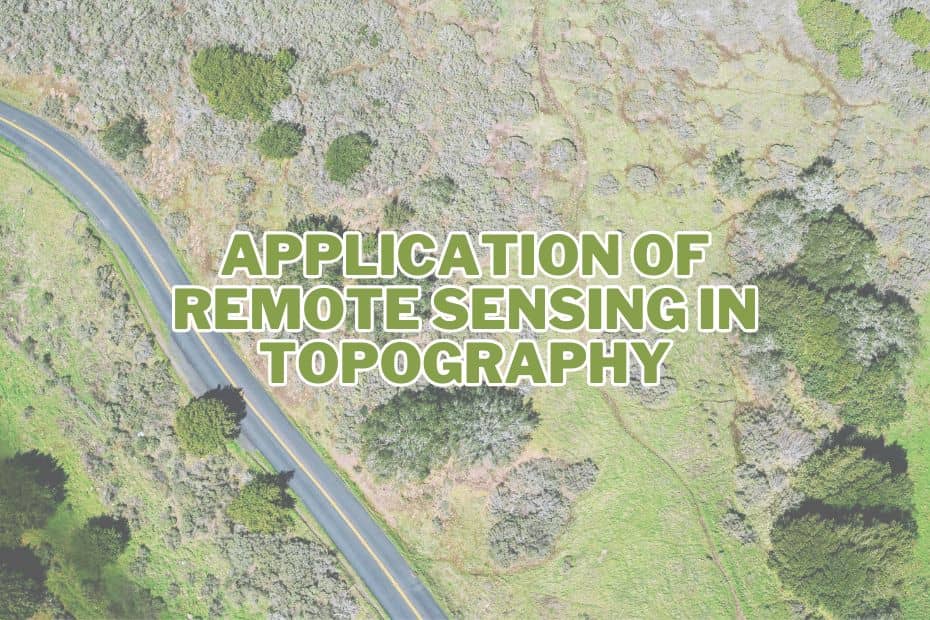In our multifaceted technological world, the application of remote sensing in topography has become instrumental. We harness the power of remote sensing technologies to scrutinize and understand the earth’s surface, paving the way for informed decision-making in various fields such as environmental monitoring, urban planning, and disaster management. In this article, we will delve deep into the multiple application of remote sensing in topography.
Remote sensing in topography involves using satellite imagery and aerial data to create highly accurate topographic maps. It’s applied across various sectors, including urban planning, disaster management, geological mapping, and environmental monitoring, providing essential insights for informed decision-making.
Application of Remote Sensing In Topography
Remote sensing allows us to acquire and interpret data about the earth’s surface without direct contact, facilitating detailed topographic analysis. The collected data aids in mapping and terrain analysis, providing intricate details about landforms, elevations, and depressions, thus giving us insight into the features and conditions of the landscape.
1. Mapping and Terrain Analysis
Mapping and terrain analysis through remote sensing are pivotal for collecting accurate topographical data. This data is vital for various applications like environmental studies, urban planning, and geological mapping. By using remote sensing technology, we can derive accurate elevation data and create detailed terrain models, which are integral for understanding landform structures, assessing slope stability, and planning infrastructure development.
2. Land Use and Land Cover Classification
Remote sensing aids in classifying land use and land cover, essential for monitoring changes in land cover types and understanding human impact on the environment. By analyzing the remotely sensed data, we discern patterns and changes in vegetation, water bodies, and urban areas, which is indispensable for natural resource management and environmental monitoring.
3. Flood Modeling and Management
Remote sensing technologies are quintessential for flood modeling and management. The acquired data helps in developing accurate flood models, predicting flood occurrence, and mitigating the impacts of floods. This technology enables us to monitor flood progression and assess the damage, essential for effective disaster management and formulating response strategies.
4. Slope Stability Assessment
The application of remote sensing in slope stability assessment provides a comprehensive understanding of terrain stability. It helps in evaluating the potential risk of landslides and slope failures, crucial for infrastructure assessment and public safety. This assessment is particularly important in areas prone to landslides due to topographical and climatic conditions.
5. Geological Mapping
Remote sensing plays a pivotal role in geological mapping, enabling the study of earth’s surface composition and structure. It is invaluable for detecting and analyzing geological features and structures, aiding in mineral exploration and earth science studies.
6. Urban Planning and Development
In urban planning and development, remote sensing is indispensable for obtaining accurate land information. It facilitates the evaluation of urban growth patterns and land use changes, essential for sustainable urban development and infrastructure assessment.
7. Natural Resource Management
Remote sensing is crucial for natural resource management, providing essential data on land, water, and vegetation. It aids in monitoring and managing natural resources effectively, crucial for sustaining ecological balance and environmental conservation.
8. Environmental Monitoring
Monitoring the environment is vital for understanding and managing the impact of human activities and natural processes on the ecosystem. Remote sensing aids in monitoring air and water quality, vegetation, and wildlife, contributing to the conservation of biodiversity and ecosystems.
9. Infrastructure Assessment
Assessing infrastructure is crucial for urban development and disaster management. Remote sensing provides valuable information about the condition and vulnerabilities of infrastructure, essential for planning, development, and maintenance.
10. Archaeological Site Detection
Remote sensing technology has revolutionized archaeological studies by enabling the detection of archaeological sites and features. It offers non-invasive methods to explore and study ancient civilizations, contributing to our understanding of human history and cultural heritage.
11. Disaster Management
In disaster management, remote sensing technology is invaluable for monitoring and assessing the impacts of natural and man-made disasters. It helps in formulating effective response strategies and mitigating the risks associated with disasters such as floods, earthquakes, and wildfires.
12. Climate Change Studies
Studying climate change is paramount in the modern era. Remote sensing provides critical data on climatic variables and changes in the environment, enabling the study of climate patterns and the impacts of climate change on ecosystems and human societies.
Conclusion
The application of remote sensing in topography is redefining our approach to understanding and interacting with our environment. From detailed landform analyses to environmental monitoring, it unlocks advanced insights, aiding in various fields like urban planning, resource management, and disaster management. By leveraging remote sensing technologies, we are paving the way for informed decision-making and sustainable development.
FAQs: Application of Remote Sensing In Topography
What is remote sensing in topography?
Remote sensing in topography is the use of aerial or satellite-based sensors to collect data about the Earth’s surface to create accurate topographic maps and terrain models.
How does remote sensing help in creating topographic maps?
Remote sensing instruments capture images and data about the Earth’s surface, which are then used to create elevation models, contour maps, and 3D representations of the terrain.
What are the key applications of remote sensing in topography?
Remote sensing in topography is used for land surveying, urban planning, flood modeling, natural resource management, geological exploration, and environmental monitoring.
What types of remote sensing technologies are commonly used in topography?
Common technologies include LiDAR (Light Detection and Ranging), radar, and optical sensors aboard satellites and aircraft. These sensors capture elevation data and imagery.
How does LiDAR technology contribute to topographic mapping?
LiDAR uses laser pulses to measure distances between the sensor and the Earth’s surface. By analyzing the time it takes for the laser beams to return, it creates highly detailed elevation models for topographic mapping.
